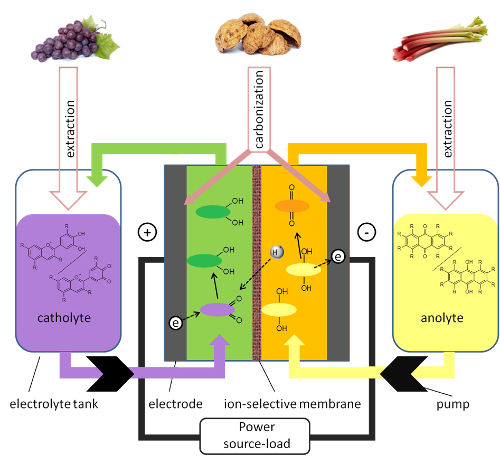031B0116

| Period: | 01.03.2016 – 30.11.2016 |
|---|---|
| Funder: | Federal Ministry of Education and Research (BMBF) |
| Project Manager: | Jürgen Schuster, Bastien Burek |
| Research Groups: | Electrochemistry, Chemical Technology |
Redox-flow-batteries are a special type of battery in which the energy storage is realized with redox compounds dissolved in liquid electrolytes. Unique in redox-flow-systems is the independent scalability of power and storage capacity. Based on these benefits as well as the long lifetime, low self-discharge rate, low costs and flexible construction this technology is promising for the intermediate storage of volatile regenerative power.
A well-known type of these batteries is the all-vanadium redox-flow-battery in which the electrolytes contain different vanadium salts. Since vanadium is expensive and the global production volume is rather limited, it is necessary to look for a widely available cheap and abundant alternative.
Organic redox-active compounds are discussed as a possible solution for this problem. They are especially suitable as electrolyte material for redox-flow-systems due of their wide availability, tunable redox-potential and solubility, practically unlimited resource base and potentially low costs with economy-of-scale. Incidentally, some of the discussed families of compounds are also found in nature. Since these substances can be obtained easily by extraction out of food waste, such as pomace from wine or juice production, there is also no competition with food production.
In the context of this project a bio-based Redox-Flow-Battery shall be developed (cf. Figure 1). First, research will focus on which biologically available compounds are suitable and under which conditions a longtime stability can be reached. Afterwards, extraction processes will be developed and the actual plant extracts tested as electrolytes.
Besides the electrolytes, electrodes also can be obtained from biological resources. For this purpose, biological side products such as nut shells will be carbonized to get highly porous carbon materials that are well-suited as electrode materials.

Figure 1: Schematical illustration of a bio-based redox-flow-battery out of sustainable resources.
back